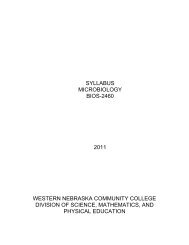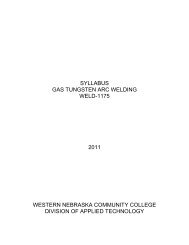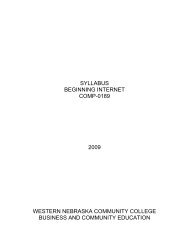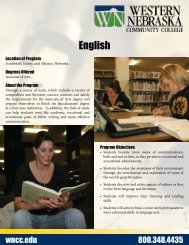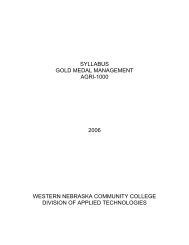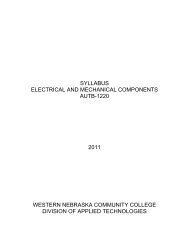View Current Syllabus - Western Nebraska Community College
View Current Syllabus - Western Nebraska Community College
View Current Syllabus - Western Nebraska Community College
Create successful ePaper yourself
Turn your PDF publications into a flip-book with our unique Google optimized e-Paper software.
EMT-INTERMEDIATE 1-B<br />
EMTL-2220<br />
Behavioral Objectives<br />
2. Describe the epidemiology, including<br />
incidence, morbidity, mortality, risk factors,<br />
and prevention strategies for the patient<br />
with a burn injury.<br />
3. Describe the pathophysiologic<br />
complications and systemic complications<br />
of a burn injury.<br />
4. Identify and describe types of burn<br />
injuries, including thermal burn, and<br />
inhalation burn, a chemical burn, electrical<br />
burn, and a radiation exposure.<br />
5. Identify and describe the depth<br />
classifications of burn injuries, including<br />
superficial burn, a partial thickness burn, a<br />
full thickness burn, and other depth<br />
classifications described by local<br />
protocols.<br />
6. Identify and describe methods for<br />
determining body surface area<br />
percentages of a burn injury including the<br />
“rule of nines”, the “rule of palms”, and<br />
other methods described by local<br />
protocols.<br />
7. Identify and describe the severity of a<br />
burn including a minor burn, a moderate<br />
burn, a severe burn, and other severity<br />
classifications described by local protocol.<br />
8. Differentiate criteria for determining the<br />
severity of a burn injury between a<br />
pediatric patient and an adult patient.<br />
9. Describe special considerations for a<br />
pediatric patient with a burn injury.<br />
10. Discuss considerations which impact<br />
management and prognosis of the burn<br />
injured patient.<br />
11. Discuss mechanisms of burn injuries.<br />
12. Discuss conditions associated with<br />
burn injuries, including trauma, blast<br />
injuries, airway compromise, respiratory<br />
compromise, and child abuse.<br />
13. Describe the management of a burn<br />
injury, including airway and ventilation,<br />
circulation, pharmacologic, nonpharmacologic,<br />
transport considerations,<br />
psychological support/communication<br />
Skills Lab Objectives<br />
Demonstrate body substance isolation<br />
procedures during assessment and<br />
management of patients with a burn injury.<br />
Perform assessment of a patient with a<br />
burn injury.<br />
10



